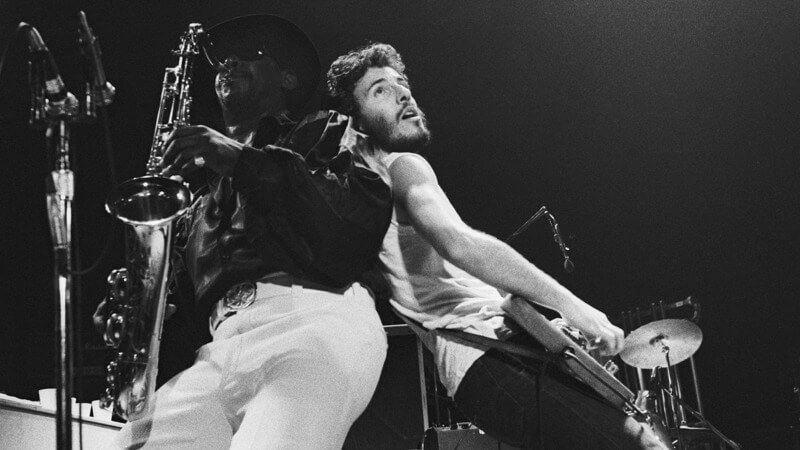In 1973, Bruce Springsteen Wrote the Greatest Summer Song Ever
Tucked into the saga of his second album, “4th of July, Asbury Park (Sandy)” became the perfect noise for lying belly-up in the dog days of July.
Photo by Allan Tannenbaum/Getty Images
In June 1973, Bruce Springsteen and the E Street Band went to 914 Sound Studios to make their second album of the year, The Wild, the Innocent & the E Street Shuffle. He’d recorded his debut, Greetings from Asbury Park, N.J., with Mike Appel and Jim Cretecos the previous summer, pinching pennies just so they wouldn’t blow through their advance from Columbia Records. Upon Greetings’s descent into our reality, it sold poorly but earned a tip of the cap from the best critics of the era. Lester Bangs said that Bruce’s lyrics “revel[ed] in the joy of utter crass showoff talent run amuck and totally out of control,” while Peter Knobler wrote that he sang “with a freshness and urgency I haven’t heard since I was rocked by ‘Like a Rolling Stone.’” “[Greetings from Asbury Park, N.J.] rocks, then glides, then rocks again,” Knobler added. “There is the combined sensibility of the chaser and the chaste, the street punk and the bookworm.” Robert Christgau also likened Bruce’s “absurdist energy” and “unguarded teen-underclass poetry” to Dylan, crowning the 23-year-old the proverbial “next man up” in rock and roll.
In a synthesis of blues, jazz, soul, and first-wave rock and roll, Bruce Springsteen and the E Street Band embraced their fullness on “Rosalita (Come Out Tonight),” “Incident on 57th Street,” and “New York City Serenade.” Gone were the folkish aspirations of Greetings from Asbury Park, N.J., substituted for The Wild, the Innocent & the E Street Shuffle’s enthusiastic, vibrant ruckuses made by six men eight miles deep into one of the greatest pockets of all time. The urban sprawls, the sweeping cinema of New Jersey living shaded by nightfall, the hot-rod language, and coming-of-age disquiet—this is the world that lies before a sleeveless, sweating God. And hearing the East Coast streets growl with fortune tellers, strongmen, alley rats, and arcade games, I think of the moon and the stars and the planets and the satellites and the little bitty space men that Wolfman Jack was yammering about. But Pat Carty may have said it best about The Wild, the Innocent & the E Street Shuffle: “If I want to beam like an idiot and remember why I fell in love with music in the first place, this is the Springsteen record I put on.”
Less than five minutes into The Wild, the Innocent & the E Street Shuffle, I greet “4th of July, Asbury Park (Sandy)” and its pull-apart, inexhaustible fountain of story. I turn to what Philip Seymour Hoffman, as Bangs, said in Almost Famous 25 years ago: “Music, true music—not just rock and roll—it chooses you. It lives in your car, or alone, listening to your headphones, with vast, scenic bridges and angelic choirs in your brain. It’s a place apart from the vast, benign lap of America.” Sandy is there, and the Independence Day fireworks are raining over Little Eden. Switchblade lovers bump shoulders with pinball wizards, casino boys dance shirtless, greasers wake up on the beach in the hands of cops, factory girls flirt beneath the boardwalk, and a waitress, dressed like a star, kisses a boy in their parked car. I know them all even if I’ve never met any of them. In Bruce Springsteen’s music, days bleed out slowly. There’s room for us in the mess and the light, and I adore “Sandy” because it’s a song that chronicles a young life becoming different for people who no longer belong. It’s a love song about somebody you won’t love forever. “Sandy,” Bruce sings, ditching the hushes and the yawps, “the aurora is rising behind us,” and you can feel the dim start to slide down your back.
The sentimental color of Danny Federici’s accordion and the drama of Suki Lahav’s voice spring a premonition: “This pier lights our carnival life forever.” The song, I always argue, is not only a time machine but an acknowledgement of a broken vow as it’s being made. “Oh, love me tonight and I promise I’ll love you forever,” Bruce coos, taking inspiration for “Sandy” from Van Morrison’s childlike, wintry vision of Belfast on Astral Weeks, namely in “Madame George.” The image of Van singing “The love that loves to love the love” becomes a portal to a room full of ghosts and laughing and dancing, just as a tilt-a-whirl spun Bruce into a realm of women on fire, unsnapped jeans, a tired boardwalk life, and a bon mot quaking in his worn splendor: “Did you hear the cops finally busted Madame Marie for tellin’ fortunes better than they do?”